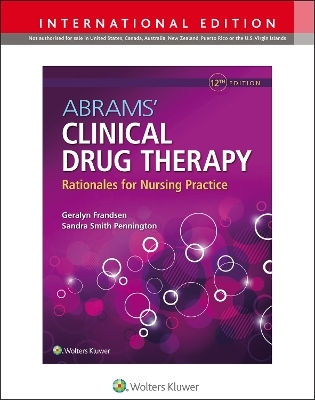
Abrams' Clinical Drug Therapy
Wolters Kluwer Health (Verlag)
978-1-9751-6017-3 (ISBN)
- Titel erscheint in neuer Auflage
- Artikel merken
Filled with case studies, concept maps, and other engaging features, this updated edition establishes a solid foundation for understanding clinical drug therapy, reflects the latest evidence-based standards for administration, and details how to prevent or minimize adverse effects. A robust suite of online resources complements the text to guide students to success throughout their courses, NCLEX® exams, and nursing careers.
Nursing Process Concept Maps simplify guidelines for visual learners.
QSEN Safety Alerts help students ensure compliance with standards for safe practice.
Clinical Application Case Studies reflect the SBAR model and challenge students to apply concepts to realistic patient care scenarios.
Clinical Reasoning Case Studies test students’ critical thinking and clinical judgment.
Unfolding Patient Stories, written by the National League for Nursing, foster valuable reflection on commonly encountered clinical scenarios.
Concept Mastery Alerts clarify commonly misunderstood concepts based on Lippincott® PrepU adaptive learning data.
Learning Objectives highlight essential chapter content.
Black Box Warnings alert students to life-threatening adverse effects identified by the FDA.
Evidence-Based Practice boxes familiarize students with the latest clinical research and its relevance for effective nursing practice.
NCLEX® Success sections reflect the latest NCLEX test plan and ready students for success on the exam.
Drugs at a Glance tables summarize the routes and dosage ranges (for adults and children), as well as the pregnancy category, for each drug in the class.
Drug Interactions and Herb and Dietary Interactions boxes highlight the risk of interactions as well as increased or decreased drug effects when drugs are combined with other medications, food, or herbal supplements.
Patient Teaching Guidelines list specific information to improve patient and family education.
Key Terms define important terminology for understanding chapter content.
SECTION 1 The Conceptual Framework of Pharmacology
1 The Foundation of Pharmacology: Quality and Safety
2 Basic Concepts and Processes
3 Medication Administration and the Nursing Process of Drug Therapy
SECTION 2 Drug Therapy Throughout the Lifespan
4 Pharmacology and the Care of Infants and Pediatric Patients
Medication Administration in Pediatrics
5 Pharmacology and the Care of Adults and Geriatric Patients
6 Pharmacology and the Care of Pregnant or Lactating Woman
7 Pharmacology and Women's Health
8 Pharmacology and Men's Health
SECTION 3 Drugs Affecting the Hematopoietic and Immune Systems
9 Drug Therapy for Coagulation Disorders
10 Drug Therapy for Dyslipidemia
11 Drug Therapy for Hematopoietic Disorders
12 Drug Therapy: Immunizations
13 Drug Therapy to Decrease Immunity
14 Drug Therapy for the Treatment of Cancer
SECTION 4 Drugs Affecting Inflammation and Infection
15 Inflammation, Infection, and the Use of Antimicrobial Agents
16 Drug Therapy to Decrease Pain, Fever, and Inflammation
17 Drug Therapy With Corticosteroids
18 Drug Therapy With Beta-Lactam Antibacterial Agents
19 Drug Therapy With Aminoglycosides and Fluoroquinolones
20 Drug Therapy With Tetracyclines, Sulfonamides, and Urinary Antiseptics
21 Drug Therapy With Macrolides and Miscellaneous Anti-infective Agents
22 Drug Therapy for Tuberculosis and Mycobacterium avium Complex Disease
23 Drug Therapy for Viral Infections
24 Drug Therapy for Fungal Infections
25 Drug Therapy for Parasitic Infections
SECTION 5 Drugs Affecting the Cardiovascular System
26 Drug Therapy for Hypertension
27 Drug Therapy for Dysrhythmias
28 Drug Therapy for Coronary Heart Disease
29 Drug Therapy for Shock and Hypotension
30 Drug Therapy for Heart Failure
SECTION 6 Drugs Affecting the Respiratory System
31 Drug Therapy for Nasal Congestion and Cough
32 Drug Therapy to Decrease Histamine Effects and Allergic Response
33 Drug Therapy for Asthma and Bronchoconstriction
SECTION 7 Drugs Affecting the Renal and Digestive Systems
34 Drug Therapy for Fluid Volume Excess
35 Nutritional Support Products, Vitamins, and Mineral Supplements
36 Drug Therapy for Weight Management
37 Drug Therapy for Peptic Ulcer Disease and Hyperacidity
38 Drug Therapy for Nausea and Vomiting
39 Drug Therapy for Constipation and Elimination Problems
40 Drug Therapy for Diarrhea
SECTION 8 Drugs Affecting the Endocrine System
41 Drug Therapy for Diabetes Mellitus
42 Drug Therapy for Hyperthyroidism and Hypothyroidism
43 Drug Therapy for Pituitary and Hypothalamic Dysfunction
44 Drug Therapy to Regulate Calcium and Bone Metabolism
45 Drug Therapy for Addison's Disease and Cushing's Disease
Section 9 Drugs Affecting the Autonomic and Central Nervous System
46 Physiology of the Autonomic and Central Nervous Systems and Indications for the Use of Drug Therapy
47 Drug Therapy for Myasthenia Gravis, Alzheimer's Disease, and Urinary Retention
48 Drug Therapy for Parkinson's Disease, Urinary Spasticity, and Disorders Requiring Anticholinergic Drug Therapy
49 Drug Therapy With Opioids
50 Drug Therapy With Local Anesthetics
51 Drug Therapy With General Anesthetics
52 Drug Therapy for Migraines and Other Headaches
53 Drug Therapy for Seizure Disorders and Spasticity
54 Drug Therapy for Anxiety and Insomnia
55 Drug Therapy for Depression and Mood Stabilization
56 Drug Therapy for Psychotic Disorders
57 Drug Therapy for Attention Deficit Hyperactivity Disorder and Narcolepsy
58 Drug Therapy for Substance Abuse Disorders
Section 10 Drugs Affecting the Eye, Ear, and Skin
59 Drug Therapy for Disorders of the Eye
60 Drug Therapy for Disorders of the Ear
61 Drug Therapy for Disorders of the Skin
Index
Appendix A Answers for NCLEX Success (online)
Appendix B Answers for the Clinical Application Case Studies (online)
Appendix C Critical Thinking Questions and Answers (online)
Appendix D The International System of Units (online)
Appendix E Serum Drug Concentrations (online)
Appendix F Tables of Normal Laboratory Values (online)
| Erscheinungsdatum | 10.05.2021 |
|---|---|
| Sprache | englisch |
| Maße | 213 x 276 mm |
| Gewicht | 2676 g |
| Themenwelt | Medizin / Pharmazie ► Medizinische Fachgebiete ► Pharmakologie / Pharmakotherapie |
| Medizin / Pharmazie ► Pflege ► Ausbildung / Prüfung | |
| ISBN-10 | 1-9751-6017-7 / 1975160177 |
| ISBN-13 | 978-1-9751-6017-3 / 9781975160173 |
| Zustand | Neuware |
| Haben Sie eine Frage zum Produkt? |
aus dem Bereich



